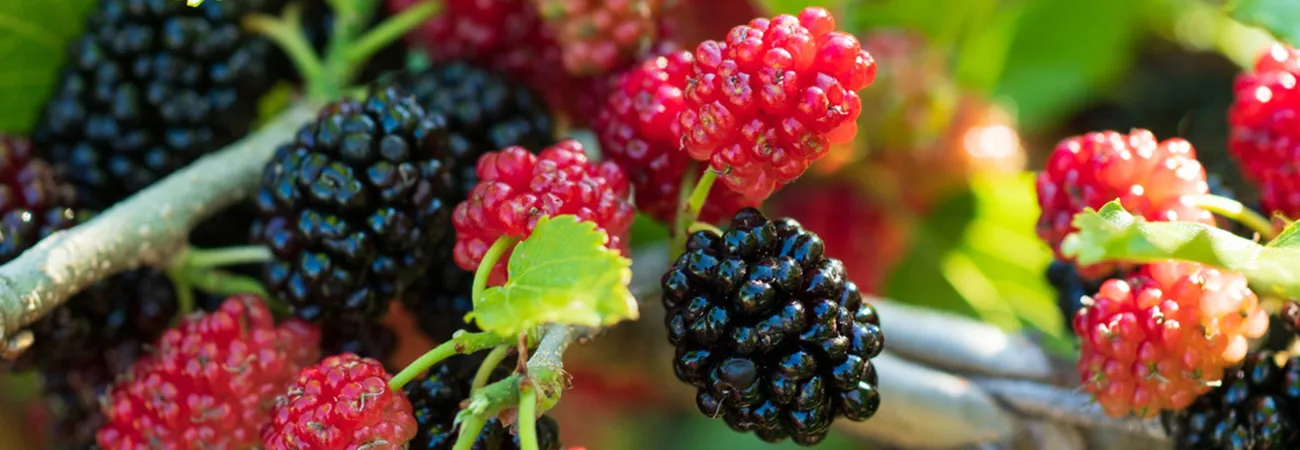i ECONOMY
Despite being a profitable produce, mulberry cultivation is not carried out on a commercial scale in Pakistan. “By promoting its cultivation at the mass level, a good number of people can be employed, especially those belonging to the cottage industry,” said Moazzam Ghurki, President of the Pakistan-China Joint Chamber of Commerce and Industry (PCJCCI). Talking to WealthPK, he said: “Silkworm rearing through mulberry trees and other value-added products can fetch a fortune for the country.” He said a mulberry tree matured in 10 months, and its leaves could be harvested several times within a year. He said that bringing awareness about the value-added products accrued from this tree could help alleviate poverty through providing people with a sustainable income source. He said that China had introduced new varieties of mulberry named Nongsang and Qiangsang, which shoot 30% more leaves. He also said that PCJCCI targeted to engage 1,000 families in mulberry cultivation and silk business in the ongoing spring season. He said that necessary training would also be provided to people to adopt the silk business.
“People interested in dealing with other value-added mulberry products will also be supported.” Talking to WealthPK, Naveed Ahmad, the assistant director of the agriculture department of Punjab, said: “In Pakistan, mulberry is not grown on a commercial scale. Most people only know its use concerning silkworm rearing, which also needs revival in Pakistan. Usually, farmers plant two or three mulberry trees in their farmlands. So, the production and market are inadequate.” Discussing the health and industrial value of mulberry, he said its extracts, powders and syrups were valuable for preparing medicines, beverages, food items, feeding animals and rearing silkworms. “Food supplements, dietary fibres, good quality vinegar and shelf life-enhancing agents for meat are also prepared from it.” He said dry cold regions like Balochistan and Gilgit-Baltistan were ideal for mulberry farming. He called for establishing processing units in these areas. “Besides all the uses of mulberry plantation, it is an important part of sericulture.
By reviving this craft like China, Pakistan can also earn a handsome foreign exchange by exporting silk. In Pakistan, it is necessary to bring awareness regarding its cultivation, value addition and income generation.” Talking about the plantation of mulberry, chief conservator forests in Balochistan forest and wildlife department Syed Ali Imran said: “The cold dry area of the province is ideal for mulberry plantation. A few famous varieties grown here are Qandhari, Qalat and Mastaung. People also graft mulberry plants.” He said besides its uses for silkworm rearing and food items, mulberry plants were also beneficial for environmental and medicinal purposes. “Balochistan covers 44% of the country’s total landmass, and through proper ecological mapping, areas can be fixed to plant mulberry trees in good numbers. People should be made aware of the economic value and industrial importance of mulberry, so they might carve out new sources of income generation.”
Talking to WealthPK, Dr Zakir Hussain Zakir, head of the department of archaeology and heritage studies at the University of Baltistan, Skardu, highlighted the environmental importance, plantation and value addition of mulberry in Baltistan. He said mulberry trees helped reduce wind speed and absorbed air and soil pollutants. “It is heavy metal resistant and a good carbon sink plant – a hectare of mulberry plantation can absorb around 648.96 kilogrammes of carbon dioxide.” He said natural silk production was once a common craft in the region, which needed to be revived. “It is necessary to promote it as a sustainable cottage industry.” He said in Baltistan, the mulberry fruit ripened in early spring, and was used for a variety of food and medicinal purposes. “Black mulberry is commonly used to cure lung diseases in traditional medicines. Four or five native varieties, including the white and black ones, occur here.
Unfortunately, regular cutting without parallel plantation is gradually making mulberry an endangered plant species in the region. People are unaware of the industrial importance of mulberry. There is a dire need to raise awareness about its environmental and industrial importance. “ As regards mulberry plantation, Aitezaz Mahfooz, divisional forest officer at the forestry planning and monitoring circle, Peshawar, said: “In the 70s and 80s, silkworm rearing was a common practice, and the provincial forest department supported silkworm farmers by providing them mulberry leaves, seeds and sometimes silk obtaining training. “But gradually, natural silk weaving declined, and so did the interest in mulberry plantation.” He said the forest department distributed saplings among farmers and community members across the province, containing 10% of mulberry plants.
He said the revival of the silk trend would help generate work opportunities, make a variety of industrial products and tackle environmental pollution. Rabia Usman, chief executive officer of a Sahiwal-based brand offering organic products, while highlighting the importance of mulberry value addition, said production of natural silk thread and cloth weaving was environment-friendly. She called for introducing innovative ways of silk production to create a new value chain in the country.
Credit: Independent News Pakistan (INP)









